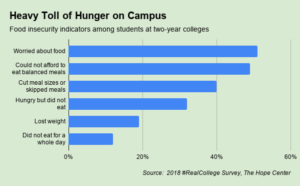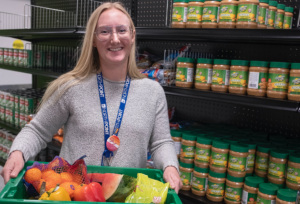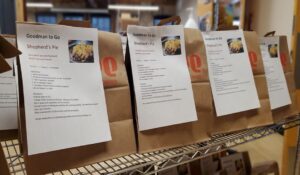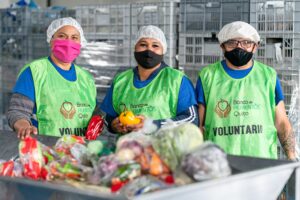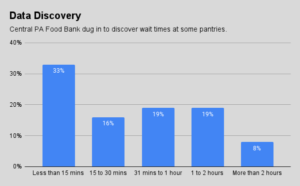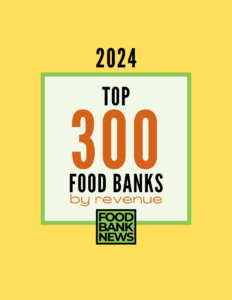At higher education institutions, innovation often happens beyond the classroom, and that’s especially true when it comes to college food pantries.
Because of the mostly young demographic being served, high-tech practices like online ordering and scheduled pickups are practically a given at college pantries. College pantries are also leading the way into innovations like refrigerated lockers. And they are proving to be experts in other aspects of addressing food insecurity, like promoting sustainability practices, making pantries highly accessible, and de-stigmatizing hunger relief.
College campuses have quickly become places where food insecurity and creative ways of addressing it mix. In a just-published report from the nonprofit Trellis Strategies, 45% of over 700,000 students surveyed reported food insecurity. The rates are higher than the general adult population due to factors such as lack of resources, concern for stigma, busy schedules and lack of cooking skills. In response, the number of food pantries in American colleges has dramatically increased from just 88 in 2012 to more than 800 from in 2022, according to Trellis Company.
The expectation for online ordering has made college pantries the fastest growing type of clientele for Cedar Mountain Software, developer of the pantry management software PantrySoft. “The main thing about the college campus pantries is they’re generally very lean, small organizations,” said Bob Jaffe, CEO. “They’re trying to act very efficiently in the way they provide their services… they had a stronger demand for detail about inventory management… and they’re much more oriented around maintaining, producing data about their usage.”

Launched in the spring of 2017, the food pantry at the State University of New York (SUNY) Schenectady has transitioned fully into online ordering using PantrySoft. Robyn King, Director of Wellness and Support Services at SUNY Schenectady who oversees the food pantry, said adopting PantrySoft has been a “game changer.” Whereas before, King and her part-time staff coordinator had to fill every order and update the inventory manually, the software has largely automated both processes and enabled quicker and more accurate data collection.
The online system also encourages visits by quantifying the amount of money saved on each order. By putting a retail value on every item, the pantry lets people see how much they have saved every time they place an order. “That has been very popular, like, ‘Wow, that means I can spend that money on something else,’” King said.
Online ordering with scheduled pickups also allows for a quicker, more dignified experience once students are in the pantry. “We’re trying to get them in and out within like two or three minutes, so it doesn’t feel like a burdensome thing to visit,” said Hend El-Buri, Director of Nutrition and Pantry at Rutgers University-Newark in New Jersey. “For us, online ordering is really part of meeting that need in a dignified way, making sure that we acknowledge that there may be a stigma around coming to a food pantry.”
Both Rutgers-Newark and SUNY Schenectady are installing outdoor food lockers this summer with plans to have them operational by fall. At Rutgers-Newark, the lockers will be centrally located, facilitating access to food. At SUNY Schenectady, there will be sixteen refrigerated lockers.
King said the lockers will be particularly helpful for students and staff who take night classes or work late and cannot make it to the pantry’s regular business hours. They will also help with preserving food safety. “I will be able to sleep better at night knowing that these foods that need refrigeration or being frozen will be safer than leaving them out,” King said.
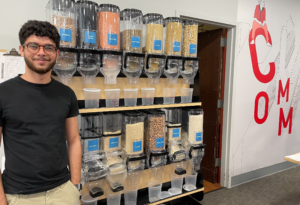
For sustainability, the Rutgers-Newark pantry — recently renamed Pantry+ — is setting an example with bulk dispensers that offer various types of pasta, beans and grains, such as basmati, jasmine rice and quinoa. Students bring their own containers to get portions of these items. The team also added spices to their offerings this past winter after conducting a cultural food survey.
The pantry benefits by being able to provide culturally appropriate food at much lower cost, while students get to engage in sustainable practices. “I think a lot of students feel left out of sustainable practices” when they can’t afford to shop at Whole Foods or stores that are only in certain neighborhoods, said El-Buri, who is currently writing a guide to help other pantries install similar refill stations. “[Now] they get this opportunity to participate in a sustainable practice that they might not usually have access to.”
At SUNY Schenectady, the pantry collaborates with student volunteers from the Sustainability Club to help collect bottles and containers to be recycled and sold through the bottle redemption program CLYNK. The funds are then used for purchasing personal care items such as toothpaste, shampoo and deodorant that the pantry can’t get from the regional food bank.
College pantries also excel at normalizing hunger relief by incorporating it into high-traffic campus locations, and even coursework. At Oklahoma University, the food pantry recently moved into a former dining hall, giving it the opportunity to create a central, welcoming space that the community truly wants to visit. There is an air hockey table, a ping pong table, TVs, couches, a growing library, and a white board where visitors have left thank-you notes to the pantry. “We’ve got an area where, sometimes, our clients will maybe bring their kids and they want to draw or color, or just any students who just want to hang out,” said Matt Marks, Assistant Director of the pantry and one of nine student founders in 2017. A collaboration with the career center is also underway to turn the pantry into a clothing store on certain days.
College pantries have also found ways to integrate into academic spaces. Oklahoma University’s pantry partnered with a multimedia class in the Journalism school in the spring of 2021 to produce a six-episode series of cooking videos. Pantry+ at Rutgers-Newark offers a self-paced course for students, faculty and staff about college food insecurity. Anyone who completes the course gets a toolkit, which includes business cards identifying them as ambassadors, which they can hand out to people. El-Buri said these students become the pantry’s most important resource, given that the majority of students who visit the pantry do so through referrals from a friend. – Kathy Ou
Kathy Ou is a reporter and critic based in New York, bred in Southern California and born in Southern China. She is a student at New York University’s Cultural Reporting and Criticism program. Her writings have appeared on Prism, AsAmNews, The Yappie, The Amp and more.
CAPTION FOR PHOTO, ABOVE: The food pantry at Oklahoma University is integrated into popular common spaces on campus.
Like what you’re reading?
Support Food Bank News


